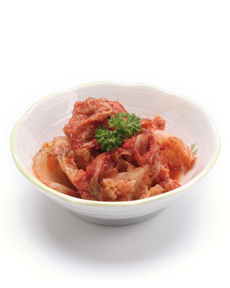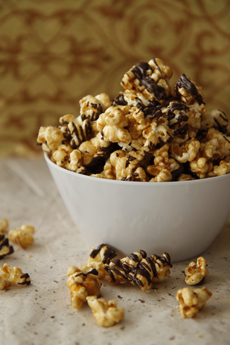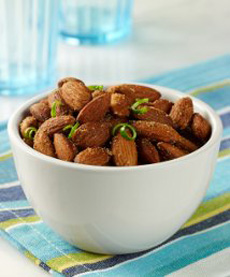|
Last month we discussed the different uses for lemon juice.
Today we’ll tackle another delicious part of the lemon: lemon zest, the grated rind of the lemon. The rind is the top layer or skin of the peel; the peel also includes some of the white pith under the skin.
How to make lemon zest? Simply hold a washed, dried lemon in one hand and run a zester over it with the other (we use a Microplane lemon zester in the photo, which comes in a variety of handle colors and is a fun party favor for Mother’s Day). Zest lightly: You only want the yellow rind, not the white pith underneath it.
If you don’t have a zester, you can use any kind of grater.
Here‘s an easy way to have fresh zest on hand all the time: Just freeze a whole washed lemon in a plastic bag.
|
|
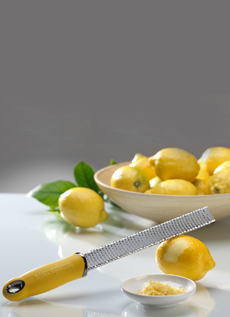
Few lemons should go unzested—and it’s so easy with a zester. Photo courtesy Microplane.
|
You can zest the frozen peel a bit at a time, as you need it, and toss or sprinkle it on top of your foods. When all the zest is gone, keep the lemon frozen until you need fresh lemon juice. Then, let it defrost, and juice away.
Freshly grated zest can make just about anything taste better. Take out the lemon and the zester as you serve:
Breakfast: cottage cheese, fresh fruit, yogurt.
Lunch: ramen, salads (chicken, egg, green, fish/seafood and potato salads), soups.
Dinner: chicken and fish recipes and garnish (including sushi and sashimi), pasta and pasta sauce, rice and other grains, salad, sauces, soups, sushi, vegetables, vinaigrette.
Dessert: baked goods, frosting/icing,* fruit salad, lemon cake, rice pudding, sorbet.
Beverages: black coffee or tea, juice, lemonade, punch, soft drinks, spritzers, spirits (neat or cocktails), wine that needs more flavor.
Condiments. Mix zest into ketchup, mayonnaise, mustard, prepared horseradish and other condiments for added verve. Also make gremolata, a lemon, garlic and parsley condiment that is delicious with fish, meat and poultry.
*The difference between frosting and icing is that icing is made with confectioners’ sugar (also called icing sugar) and frosting with table sugar; but the two terms are often used interchangeably (that doesn’t mean correctly!).
|
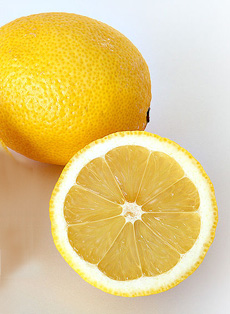
The slender zest provides intense flavor.
Photo by Andre Karwath | Wikimedia. |
|
ABOUT THE LEMON
The lemon tree, which has the botanical name Citrus limon, is a small evergreen. The fruit is used for primarily for its juice, though the pulp and zest are also used, mainly in cooking and baking. The tart taste of the lemon juice comes from citric acid, which comprises about 5% of a true lemon.
There are many different types of lemons; but the components of all lemons include:
Lemon Juice. Juice squeezed from the lemon is used as an ingredient in many recipes. Quartered lemons (or smaller divisions) are used to garnish foods so that the diner can squeeze fresh lemon juice as a condiment. Lemon juice can replace or complement vinegar in salad dressings; used in a marinade to tenderize meat, poultry or fish; to make lemonade; and to brighten a cup of tea. The juice and the zest can be used instead of salt in low-sodium cooking.
|
|
Lemon Oil. Lemon oil is added to frozen or processed lemon juice to enhance the flavor. It is also used to scent household and personal care items—furniture polishes, detergents, perfume, soap and shampoo, for example.
Lemon Peel. Lemon peel, or peeled lemon rind, includes the yellow rind and the white pith underneath. The peel is is the source of lemon oil, plus two more valuable products: citric acid and pectin. Lemon oil is used as a flavoring for hard candies; it is cut and candied in sugar syrup to make candied lemon peel, a delicious confection. The peel and the zest are also used as ingredients in confectionery and baked goods. Fresh lemon peel is served as a garnish for espresso: Rub the pith around the rim of the cup to release the lemon oil, which adds to the flavor of the drink (and offsets bitterness).
Lemon Rind. The rind is the yellow skin of the lemon, without the pith. It is most often zested.
Lemon Zest. Lemon zest, or the grated rind, is a popular flavoring for baked goods and desserts as well as in savory dishes, such as meats and sauces. The rind holds the lemon oil, and adds exciting taste. After you’ve squeezed a lemon for its juice, don’t toss it out; zest it and use the zest in anything from vinaigrette to vegetables.
|
|
